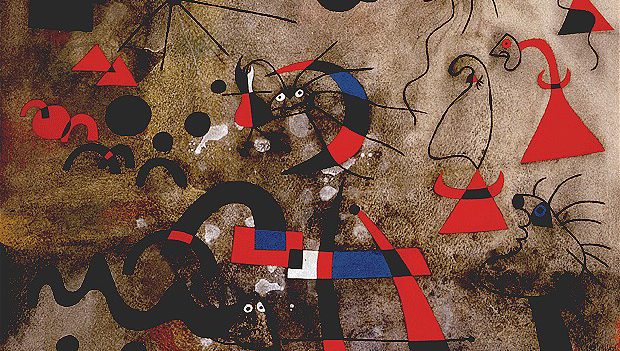Tate Modern: 14/04/2011 – 11/09/2011, Not free. Photo found on web.
Miro, colour and imagination
Joan Miro, now dead for over a 1/4 century. This major reterospective exhibition explores his career as an artist from his early drawings as a young man on the family farm at Mont-Roig to the development of his adult vocabulary and iconography as an established artist to his radical experiments in later years, allowing the viewer to see the refinement and incremental changes of medium, mode, and message explored by the artist.
Early years
The early work by Miro was exciting full of what can only be described as freedom or bliss, let us not forget the era in which Miro grew up, it was on of strong nationalist tides sweeping across his native Catalan and so one sees in his work the celebration of his native land. He spent his formative years on a farm and would have had access to materials that would allow him generate a strong relationship to the outside world as seen in ‘Catalan Landscape (The Hunter)’ and ‘The Farm’ these were strong symbolist gestures with firm nods to the mind and the unconscious.
Dog Barking at The Moon, 1926
The deceptive scale of this painting is almost quite disarming yet for its small size it is a strong piece which deserves no less attention than some of the larger works such as the ‘Blue’ triptych and ‘The Hope of a Condemned Man’. During this period Miro revisited the earlier works and refactored them into more surreal iconography. An example of this is Catalan Landscape (The Hunter). We see the detail reduced clearly, the colours appearing less vivid the overall effect of the work becoming more lucid, imaginative and surreal. Objects loose the vestiges of their original and cast off associations to cardinal reality.
Blue Triptych
This piece has to be one of the most compelling yet it betokens the most simple configuration, a blue ground sparsely populated with red and black dots, yet, a true masterpiece. It has all the signature elements which would have no doubt paved the way for artists to come like Yves Kline and the colour field abstract painting movement. The strong colour fields pulsate most affectingly and transports the viewer into a situation of serenity and contemplation. The setting of the piece made its impact resonate more strongly, the piece was arranged within a small room so as to enforce the feeling visual immersion and each painting was hung so that in effect the picture plane formed a panorama.
Later work
The work of Miro was not reconciled to paint alone he made many forays into sculpture and the use of canvas as a sculpture which at the time was a radical departure from work which he had hitherto been engaged in. For example the collection of burnt paintings in which burned picture planes were hung from the ceiling not against the wall as was traditional, this allowed the artist to deconstruct the visual paradigm of art appreciation in painting as well as instigate a shift away from what painting actually was considered then as something more than just a 2d illusion.
OUTLINE
Joan Miro – The Escape Ladder, is retrospective show which in great detail and depth focuses on the changes and events that shaped Miro the man and artist.
www.tate.org.uk/modern/exhibitions/joanmiro/
written by: Colin Humphrey
